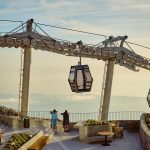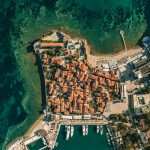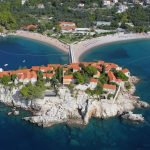Tucked into the scenic Bay of Kotor, surrounded by dramatic mountains and azure waters, the medieval town of Kotor, Montenegro, is a destination that feels untouched by time. With its UNESCO World Heritage status, winding cobblestone alleys, centuries-old churches, and romantic Venetian architecture, Kotor invites travelers to step into a living museum. This Adriatic jewel is not only visually stunning but also rich in history, culture, and adventure.
Why Visit Kotor?
Kotor offers a rare combination of natural beauty and historic charm. Unlike many coastal towns overwhelmed by mass tourism, Kotor remains authentic and atmospheric. Visitors can meander through the Old Town’s maze of narrow lanes, stumble upon quaint cafes, and marvel at architectural details dating back to the 12th century. The town’s unique setting inside Europe’s southernmost fjord creates a breathtaking backdrop for exploration. Whether you’re on a luxury cruise stopover or planning a longer stay, Kotor offers a wealth of sights and experiences that reward every type of traveler.
Old Town Kotor: A Labyrinth of History
One of the biggest draws to Kotor is its walled Old Town, a remarkably preserved example of medieval urban planning. Within these walls lies a treasure trove of churches, museums, and squares, each with its own story. The Cathedral of Saint Tryphon, originally built in 1166, is an architectural marvel with Romanesque design and a rich treasury of sacred art. Don’t miss the Maritime Museum, which showcases Kotor’s naval legacy and maritime traditions that helped shape the town’s identity. Wandering through the narrow alleys, you’ll encounter charming courtyards, hidden boutiques, and the occasional street performer adding a touch of music to the air.
Venetian Influence: A Lasting Legacy
Kotor’s long-standing connection with the Republic of Venice is evident throughout the city’s architecture, art, and fortifications. From 1420 to 1797, Kotor was under Venetian rule, a period that left a profound mark on the town’s cultural and architectural development. The iconic winged lion of Saint Mark, the symbol of Venice, can be seen adorning many buildings. Venetian-style palaces, intricate stone carvings, and the layout of the Old Town itself reflect this influence, contributing to Kotor’s unique blend of Balkan and Italian heritage. The Palazzo Pima and Grubonja Palace are just two examples of grandiose structures that recall this elegant legacy.
The Bay of Kotor: Nature’s Masterpiece
Beyond its urban charm, Kotor is embraced by the awe-inspiring Bay of Kotor (Boka Kotorska). This natural harbor, often mistaken for a fjord, is actually a submerged river canyon and one of the most picturesque landscapes in Europe. Scenic boat tours are a must, offering views of nearby islets like Our Lady of the Rocks and the quaint town of Perast. Kayaking, sailing, and paddleboarding are also popular ways to enjoy the calm, crystal-clear waters. Nature enthusiasts will find plenty of photo opportunities as the light shifts across the bay, creating magical reflections that change by the hour.
Kotor’s Fortifications: A Stairway Through Time
Towering above the Old Town are the ancient fortifications of Kotor, an essential part of its historical defense system. Climbing the 1,350 steps up to the Castle of San Giovanni rewards adventurers with panoramic views over the bay and town. These ramparts, built and expanded over centuries by Byzantines, Venetians, and Austrians, are more than a photo opportunity—they’re a testament to Kotor’s strategic importance through the ages. [Link here to detailed article on fortifications.] Along the way, you’ll pass chapels and lookouts that invite quiet moments of reflection, each stone bearing the scars and stories of past centuries.
Local Culture and Cuisine
Kotor’s cultural life is deeply influenced by its maritime past and its position at the crossroads of East and West. From lively summer festivals to sacred religious processions, the town is alive with tradition. Culinary delights await around every corner, with seafood taking center stage. Try grilled octopus, black risotto, or fresh mussels paired with local Vranac wine. For dessert, indulge in priganice—fried dough balls served with honey or jam. The local markets offer a glimpse into everyday life, brimming with seasonal produce, cheeses, and cured meats that reflect the flavors of the region.
Festivals and Events in the Old Town
Kotor’s Old Town plays host to a lively calendar of cultural, musical, and traditional events throughout the year. The town comes alive during the annual Kotor Carnival in February, a celebration featuring elaborate costumes, street parades, and music. In summer, the KotorArt Festival brings world-class performances in classical music, theater, and visual arts, drawing both international and local artists. Another standout event is Boka Night (Bokeljska Noc), a dazzling evening held in August with illuminated boat parades and fireworks that light up the bay. These festivities, along with local fairs and folklore performances, provide a vibrant window into the region’s spirit and traditions. The Summer Fiestas, featuring open-air concerts and food fairs, are perfect for experiencing the town like a local.
Day Trips and Nearby Attractions
Kotor is an ideal base for exploring Montenegro’s coastal and mountainous regions. Just a 20-minute drive away is the charming village of Perast, known for its baroque palaces and the manmade island of Our Lady of the Rocks. For nature lovers, a trip to Lovćen National Park offers dramatic vistas and a chance to visit the mausoleum of Montenegro’s beloved poet-prince, Njegoš. Adventure seekers can head inland to the Tara River Canyon for whitewater rafting or zip-lining. The newly opened Kotor Cable Car provides a thrilling ascent from the bay to the highlands of Lovćen, offering panoramic views that stretch across the Adriatic coast. Scenic boat tours departing from Kotor’s harbor are also popular, taking visitors around the bay and to nearby attractions like the Blue Cave or the beaches of Dobrec. For those looking to explore more of Montenegro’s coastal charm, the vibrant seaside town of Budva is just under an hour away and offers sandy beaches, nightlife, and an ancient walled town. Further along the coast, Herceg Novi boasts botanical gardens, a historic fortress, and a lively promenade perfect for a relaxing day trip. Inland, the ancient capital of Cetinje and the Ostrog Monastery, built dramatically into a cliff face, offer deeper cultural immersion.
Hidden Gems and Unique Experiences
Beyond the well-known sights, Kotor offers a range of lesser-known experiences for those willing to wander off the beaten path. Visit the small but fascinating Cats Museum, dedicated to Kotor’s unofficial mascots, or take a guided walking tour to uncover stories of pirates, plagues, and princes. Coffee lovers should seek out local kafanas—traditional cafés where you can savor strong espresso or rakija with the locals. Photographers and artists will find endless inspiration in the textures and tones of Kotor’s weathered stone walls, ivy-draped arches, and sun-dappled squares.
When to Visit Kotor
The best times to visit Kotor are during the shoulder seasons of spring (April to June) and autumn (September to October). These months offer pleasant weather, fewer crowds, and vibrant local life. Summers can be quite hot and busy, especially when cruise ships dock, but they also bring festivals, concerts, and a lively waterfront scene. Winter, while quieter, presents a different kind of charm—misty mornings, peaceful alleys, and a slower pace that invites true relaxation.
Practical Tips for Travelers
- Currency: The official currency is the Euro (EUR).
- Language: Montenegrin is the official language, but English is widely spoken in tourist areas.
- Transportation: Kotor is well-connected by bus to other Montenegrin cities. The nearest airport is Tivat, just 15 minutes away by car.
- Accommodations: Options range from boutique hotels in restored palaces to budget-friendly guesthouses. Booking early is recommended during high season.
- Local Etiquette: Dress modestly when entering churches. Tipping (around 10%) is customary in restaurants.
- What to Pack: Comfortable walking shoes are essential for navigating the cobblestone streets and climbing the city walls. Bring layers, as the temperature can change quickly, especially if venturing into the mountains.
A Destination to Remember
Whether you’re wandering through medieval streets, sailing across the glassy bay, or hiking to ancient ruins, Kotor leaves a lasting impression. It’s a place where past and present harmoniously coexist, offering a rich experience for every type of traveler. From history buffs and foodies to adventurers and romantics, Kotor, Montenegro, is a must-visit destination on the Adriatic coast.
Plan your journey today, and let Kotor’s timeless charm sweep you off your feet.





